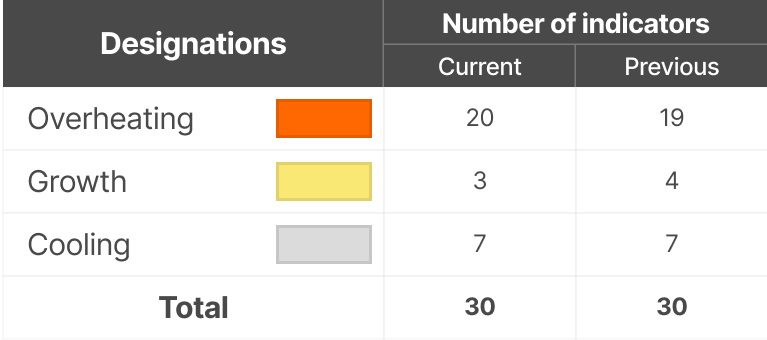Dashboard for assessing current economic activity (12/02/2022)
According to the dashboard results for November, 20 out of 30 factors indicate an overheating of the economy. The analysis was carried out in 4 blocks: inflation, monetary, economic and external terms. A semantic analysis of the National Bank of the Republic of Kazakhstan press release was also carried out.


1 indicator in the inflation block has moved into the overheating zone in comparison with the previous dashboard. The increase in price factors overheating is getting worse, while business activity and economic growth, on the contrary, show cooling. Increasing stagflation risks are likely to be a factor in maintaining budget spending at elevated levels. In these circumstances, an excessive increase in interest rates may contribute to an additional expansion of the budget deficit, thereby complicating the ability to keep inflation under control. Given the growing risks regarding the prospects for the development of the domestic economy, the main issue in ensuring sustainable growth and stable inflation is a balanced approach to decision-making, as well as the consistency of budgetary and monetary policy measures.
Read more in the paper
Jusan Analytics
Related News
09 October 23
How not to be unemployed: what you need to know about the future labour market
Experts of the World Economic Forum (WEF) presented new forecasts for business, professions and skills development in the next 5 years. The study is based on surveys of the largest employers and their expectations regarding business development, professions and skills. The survey involved 803 companies employing more than 11.3 million people, covering 27 industry clusters and 45 economies worldwide.
Key insights:
- Employers expect structural changes in 23% of jobs;
- The "green" economy is the main source of new jobs;
- Economic challenges are the greatest threat to the labour market;
- Advanced technologies will remain a key driver in business transformation;
- About 75% of the surveyed companies plan to implement AI by 2027;
- Up to 43% of all business tasks will be performed by machines in the coming 5 years;
- The most popular profession is artificial intelligence and machine learning specialists;
- Analytical thinking is a key skill for a successful career;
- 47% of the surveyed employers evaluate their skills when selecting candidates, and 45% require a diploma;
- In the next five years, 44% of the basic skills of employees will become obsolete and 6 out of 10 employees will have to undergo training.
Periodic Researches
Businesslabour marketAlexandra Molchanovskaya
06 September 23
Financial analytics: How much do we spend on routine expenditures?
We face a variety of expenses that vary depending on our needs, circumstances and preferences in our daily lives. Some people need quality food, others need to repay loans regularly and for some entertainment and recreation become a priority. However, the question often arises: Do we have enough income to meet all these needs? What amount of money is needed to achieve a comfortable standard of living? Is it possible to classify yourself as middle class by your expenses?
In this regard, we decided to analyze the core expenditures that each person or family needs to achieve a minimum level of comfort and meet basic life needs. As a result of the study, we divided the employees of Astana and Almaty cities into 6 groups depending on their income and expenses and also determined the size of each class: the least well-off, low-income, lower middle class, middle class, prosperous and well-off.
Key insights:
- An average of 246.3 thousand tenge or 60% of salary is spent on core expenditures every month.
- The largest amount of daily expenses is observed in the first 4 days after receiving a wage.
- At least 450 thousand tenge per month is required to satisfy all basic needs for a comfortable life in megapolicies.
- Almost half of the employed in Astana and Almaty cities (49%) do not have enough earnings to cover their daily expenses.
- The is an essential disparity between workers and cities - there are 4 times more workers with financial difficulties in Almaty than in the capital.
- Only 4.4% of employees with wages from 700 thousand to 1.2 million tenge, whose daily expenses account for 40-50% of income, can be attributed to the middle class.
- Employees with above-average incomes make up the smallest share of the employed population - 2%.
One-off Researches
ConsumptionStandard of livingAlexandra Molchanovskaya
Sign Up for the Most Helpful Mailing List